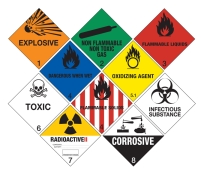Heavy Vehicle Dangerous Goods Focus of Joint Taskforce 2 Day Operation
A joint traffic task force consisting of officers from NSW Police Force Traffic and Highway Patrol as well as Roads and Maritime Services (RMS) inspectors have been targeting dangerous goods transport.
Over a 2 day period, on July 7 and 8, the joint traffic task force focussed on the loading and transport of dangerous goods.
On the first day of the operation, officers inspected 21 trucks and trailers at the RMS Heavy Vehicle Safety Station at Port Botany. They detected 28 infringements and issued notices. They also issued numerous load, defects and dangerous goods compliance issues.
Operation’s Disturbing Results
During the operation officers also inspected a truck transporting full and empty LPG cylinders. They discovered that the brake pedal of the truck could be pushed down to the floor by hand. They also found a number of cylinders unsecured. The truck didn’t have a safety kit or emergency procedure guides, as heavy vehicles carrying dangerous goods should have.
Another truck inspected on the first day was loaded with pallets of dangerous goods and corrosives but they hadn’t been properly restrained, leading to the load shifting. The truck also didn’t have correct signage and load manifest. There was no emergency procedures guide or personal protection equipment. Upon investigation officers discovered the driver wasn’t trained to convey dangerous goods.
The second day of the operation at a distribution centre in southwest Sydney didn’t yield much better results.
During their investigations officers inspected 802 trucks and trailers and issued 28 defect notices for 128 faults such as ancillary equipment, body and chassis, wheels and tyres, brakes, oil and fuel leaks as well as other issues.
A common infringement detected was trucks carrying dangerous goods that didn’t have a ‘Dangerous Goods’ placard. Officers also found a number of vehicles transporting dangerous goods that were overloaded and/or the loads weren’t properly restrained.
Only one driver tested positive to methamphetamine, out of the 71 randomly tested.
Officers downloaded 5 engine control modules (ECM), leading them to discover 2 trucks with speed limiters that had been tampered. These trucks were defective and grounded.
Thirty-one infringement notices and 12 charges relating to licencing and registration, loads, defects, fatigue, work diary and similar problems were issued.
Acting Assistant Commissioner Stuart Smith of the Traffic and Highway Patrol Command expressed his concern about how poorly dangerous goods were being managed on our roads. His comments were posted on the NSW Police’ website,
“The goods are dangerous for obvious reasons, in the event of a crash of any sort, there will be significant safety risks for all involved.”
“Dangerous goods need to be managed and transported to strict standards, for the protection of not only those involved in conveying the load, but also other road users.”
Source: www.police.nsw.gov.au
[Tweet “Dangerous goods need to transported to strict standards, for the protection of everyone.”]
He also explained that trucks not displaying proper Dangerous Goods placards creates significant issues for Fire & Rescue NSW and the Rural Fire Service.
These operations contributed to a 14 percent reduction in heavy vehicle crashes and 24 percent reduction in related deaths. He went on to explain:
Traffic and Highway Patrol Command, working with Roads and Maritime will continue to rigorously enforce heavy vehicle compliance in NSW to bring these sad statistics down even further.”
“Whilst our joint enforcement programs will continue, those involved in the loading and transport of Dangerous Goods must be compliant to assist us in driving down the road toll.”
Source: www.police.nsw.gov.au
RMS General Manager of Compliance Operations Paul Endycott said the agency and New South Wales Police Force have been very clear to the industry about non-compliance with heavy vehicle laws. Mr Endycott stated:
“Of particular interest are the decisions by executives of the businesses that drive the need to obtain an unfair commercial advantage at the cost of good and compliant businesses. The message is clear you must lift your game and take responsibility, not leave it to these operators to shoulder all the compliance burden. These operations will continue until this culture of noncompliance and unsafe practices are driven from the industry. Chain of responsibility investigations from today’s operation will continue,”
Source: www.police.nsw.gov.au
As Mr Endycott explains, chain of responsibility investigations will continue, a warning that the industry should heed if they want to avoid serious consequences.
Ensuring drivers and everyone involved in the supply chain is aware of their responsibilities means providing them with Chain of Responsibility training. To find out more, click here.



